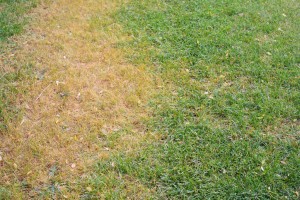 When trying to keep a well-manicured lawn, there’s nothing quite as frustrating as having brown grass. Unfortunately, this is merely a symptom that can be caused by anything from poor mowing practices to fungal infections. Here’s how you can find the root cause and fix it.
When trying to keep a well-manicured lawn, there’s nothing quite as frustrating as having brown grass. Unfortunately, this is merely a symptom that can be caused by anything from poor mowing practices to fungal infections. Here’s how you can find the root cause and fix it.
Dull Mower Blades
When a dull mower blade strikes the grass, it tears off the top instead of slicing it. This damages the grass and leaves it open to infection. If you see jagged edges on the tips of the grass, it’s time to sharpen your blades.
Scalping
If the mower is set too low, the blades will cut so much of grass that it will have a hard time recovering.
Low cutting will also slice into crowns, damaging the base of the plant and its connection to the root system.
Most turf grasses are healthiest if they’re kept to a length of 1.5-2 inches, while some varieties like tall fescue and St. Augustine need to be kept between 2-3 inches. When mowing, the grass will recover faster if you trim no more than 1/3 of the total height at one time.
Compacted Soil
If the soil is too hard for roots to penetrate, the grass won’t get the nutrients it needs. It’s common for pooling water on compacted soil to grow moss alongside brown grass. Compacted soil on slopes will let water slide off, causing erosion along the base of the hill that further damages the root system.
Thatch
If this surface layer of dead plant matter is over ½ inch thick, the amount of air and water that reaches the root system is reduced and those roots can grow up into the thatch.
Mulching grass will boost the growth of microorganisms, and in turn these tiny creates will eat the thatch, keeping it from getting too thick. Thicker growth will need to be removed with a dethatcher.
Dormancy
High heat and drought conditions will cause grass to go dormant, turning it brown but keeping it alive. If this happens, wait until temperatures drop before watering the grass. Trying to bring it out of hibernation too soon can leave the grass unprotected against heat. To prevent dormancy, keep the lawn watered and let the grass grow taller to act as a sunshade.
Fertilizer Burn
The nutrients in fertilizer come in the form of salts. Add too much, and these can suck the water out of plants, leaving them brown and dry. Burn can appear a day or two after fertilizing with standard fertilizers, or as long as two weeks later with slow release fertilizers.
To prevent burn, get a soil test so you can apply exactly what the plants need and nothing more. Slow-release formulas are less likely to cause burn than standard fertilizers.
To reverse the effects of burn, scoop up as much of the fertilizer as possible, and keep the soil moist to wash away excess nutrients.
Animal Waste
Dog urine, bird feces and anything else that comes out of the rear end of an animal is high in nitrogen, causing localized burn. You can reduce the effects from your pets by keeping them hydrated, having them pee in different parts of the yard and watering those areas to dilute the nitrogen.
Fungus
Brown spots not caused fertilizer burn are usually the result of mold. There are four types of mold that are common on lawns, each with its own symptoms:
- Brown patch – Brown spots covering an area three to 16 feet in diameter
- Take-all root rot – Brown-yellow spots with small black dots on the underside of grass blades
- Dollar spot – Small brown spots under 6 inches in diameter
- Snow mold – Grayish patches that show up in early spring
Managing soil compaction and thatch build-up will keep the soil from getting overly moist, preventing the spread of fungus.
Dead Sod
There’s not much you can do if your newly-laid sod dies off, but there are ways you can ensure its success. This starts by adding fertilizer to the soil before laying the sod. Once the sod is on the turf, water it daily for the first week to encourage shallow root growth, then slowly increase time between watering to encourage deeper root growth.
Avoid vehicle and foot traffic, and wait at least 48 hours between the last watering or rain before the first mow. If the ground is disturbed before the roots have worked their way into the soil, the sod can separate from the underlying soil.
Keep Your Equipment Ready to Manage Lawn Problems
If you own an aerator, sod cutter, dethatcher or anything else made by Billy Goat, you can get the parts and accessories you need from www.billygoatparts.com. We’re a certified dealer for Billy Goat as well as the engine and equipment manufacturers they work with, so we’re able to offer replacements for everything on your equipment. We ship to both the U.S. and Canada.
